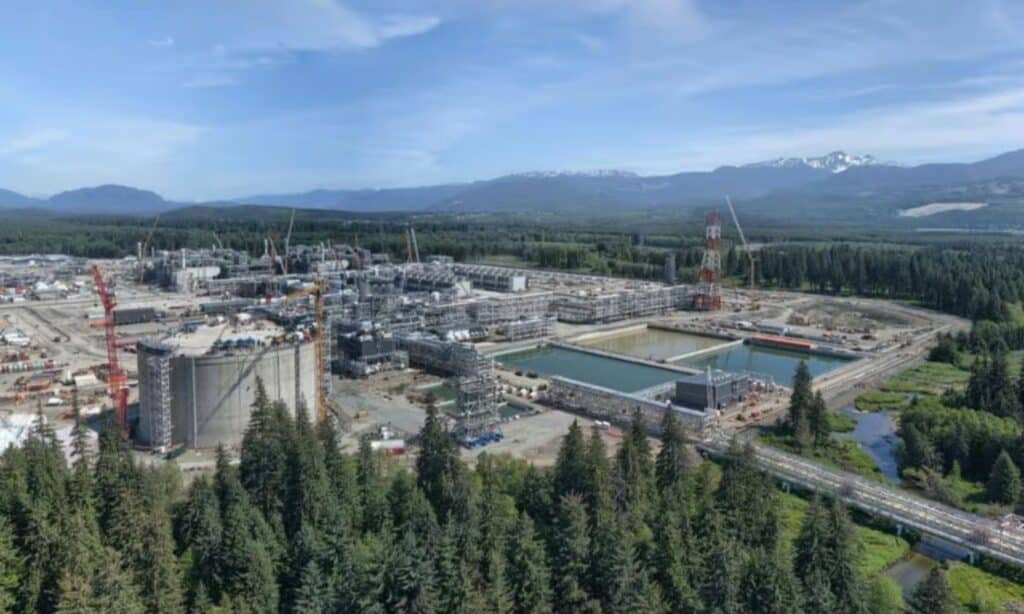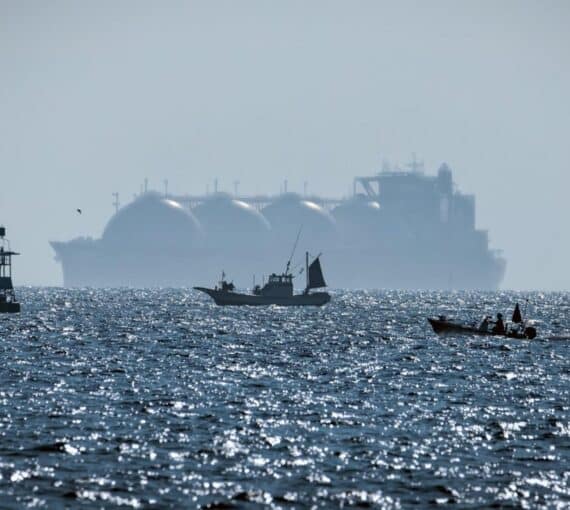
In recent weeks and months, the fossil fuel lobby and its supporters in governments of all political stripes have been touting the putative benefits of liquefied natural gas. (Photo: LNG Canada)
The fossil fuel industry is on a roll. Emboldened by global crises, big oil and gas companies are awash in cash from historically unprecedented profits and determined to seek ever more profit, no matter the cost.
In recent weeks and months, the fossil fuel lobby and its supporters in governments of all political stripes have been touting the putative benefits of liquefied natural gas. It’s been a full court press of advertising, sympathetic columnists presenting one-sided opinions as if they were carefully researched facts, and reports such as the one recently published by the Canadian Chamber of Commerce that wouldn’t survive scrutiny as an undergrad economics assignment. Then there is the world’s leading fossil fuel project financier — the Royal Bank of Canada — and its push for increased Canadian LNG production, the latest in a regrettable stream of greenwashing exercises.
One of the arguments most frequently made by industry lobbyists and LNG project proponents is that LNG is a “bridge fuel.” They assert that LNG can displace other climate-polluting fossil fuels such as coal, and that because LNG emits less carbon dioxide than coal when burned, it is beneficial in the effort to limit the rapidly compounding effects of the climate crisis.
A new report I wrote commissioned by the David Suzuki Foundation, “Burning Bridge: Debunking LNG as a Climate Solution,” takes a close look at the science and economics around LNG and the climate crisis and concludes that, far from being a solution, LNG exacerbates the problem.
A new report I wrote commissioned by the David Suzuki Foundation, “Burning Bridge: Debunking LNG as a Climate Solution,” takes a close look at the science and economics around LNG and the climate crisis and concludes that, far from being a solution, LNG exacerbates the problem.
Specifically, LNG locks up investment, locks in emissions and locks out renewables — the three locks. In the wake of the latest unmistakably clear “final warning” to humanity issued by the United Nations in the Intergovernmental Panel on Climate Change’s comprehensive Sixth Assessment report, the three locks keep us on the road to climate chaos.
LNG projects are capital intensive. In fact, LNG Canada’s Phase 1 project in Kitimat, British Columbia, with a price tag of $40 billion, is the largest private sector project in Canada’s history. Because of the enormous capital cost of building LNG infrastructure, such projects must operate for decades to first break even and then turn a profit. That’s problematic when we have very little time left to dramatically reduce gas consumption.
In the case of Canadian LNG more than 90% of the gas that will travel via Coastal GasLink’s 640-kilometre pipeline to LNG Canada’s Kitimat facility will be fracked. Methane emissions from the fracking process are potent drivers of climate change — as methane is roughly 30 to 80 times more potent than carbon dioxide.
On the existential issue of emissions, LNG supporters carefully avoid comprehensive analyses of LNG emissions from wellhead to the end consumer. They prefer to focus on those liquefaction facilities that will use electricity to manufacture LNG leaving out all the other steps of the industrial process integral to production and emissions up to the point of delivery. In the case of Canadian LNG — the focus of the report — more than 90% of the gas that will travel via Coastal GasLink’s 640-kilometre pipeline to LNG Canada’s Kitimat facility will be fracked. Methane emissions from the fracking process are potent drivers of climate change — as methane is roughly 30 to 80 times more potent than carbon dioxide. In addition to emissions, fracking is also associated with serious health and water impacts.
Then there is the cost of renewable energy, which has plummeted in recent years and is now the cheapest source of energy in many parts of the world, much more cost-effective than fossil fuel infrastructure. But if billions of dollars in private investment capital and billions more in government subsidies keep flowing to fossil fuel projects, we cannot fully leverage the cost and clean energy advantages of renewable energy.
To be a climate leader, Canada must not add fuel to the fire by allowing any further expansion of the LNG industry.
The federal and British Columbia governments have taken some positive steps in addressing the climate crisis. At the same time, they have worked against their own best efforts by financially supporting and approving new fossil fuel projects, such as the recent Cedar LNG project. With big oil and gas companies exerting their influence via lobbying, advertising and misinformation campaigns, governments need to listen to the science. LNG is not a climate solution in a world that desperately needs to decarbonize as quickly as possible. To be a climate leader, Canada must not add fuel to the fire by allowing any further expansion of the LNG industry.
Daniel Horen Greenford is a postdoctoral researcher at Concordia University. He holds a PhD in Geography, Urban and Environmental Studies.
This op-ed was originally published in Corporate Knights.
Always grounded in sound evidence, the David Suzuki Foundation empowers people to take action in their communities on the environmental challenges we collectively face.



